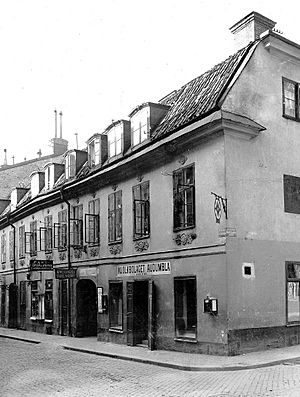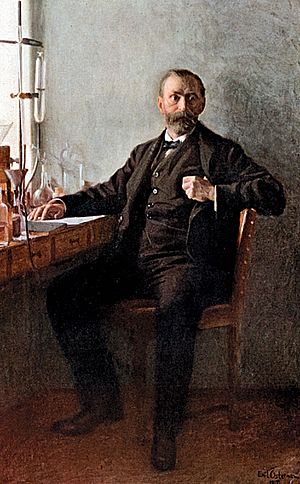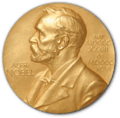Alfred Nobel facts for kids
Quick facts for kids
Alfred Nobel
|
|
|---|---|

Alfred Nobel
|
|
| Born |
Alfred Bernhard Nobel
21 October 1833 |
| Died | 10 December 1896 (aged 63) Sanremo, Italy
|
| Occupation | Chemist, engineer, inventor, businessman, philanthropist |
| Known for | Benefactor of the Nobel Prize, inventor of dynamite |
| Signature | |
Alfred Nobel (born October 21, 1833 – died December 10, 1896) was a Swedish scientist, engineer, and inventor. He is famous for inventing dynamite. He also created the Nobel Prize, which are very important awards given out every year. After he died, Nobel left a lot of money (31 million Swedish kronor) to make sure these prizes could be given out. Not many people know that Alfred Nobel was also a writer of plays!
Contents
Early Life and Learning
Alfred was the third son of Immanuel Nobel, who was an inventor and engineer. His mother was Karolina Andriette Nobel. Alfred had eight brothers and sisters, but only he and three of his brothers lived past childhood.
Alfred's father was also interested in engineering, especially explosives. Alfred learned a lot about these things from his father when he was young. His father had studied at the Royal Institute of Technology in Stockholm.
After some business problems, Alfred's father moved to Saint Petersburg, Russia. There, he became successful by making tools and explosives. He even invented a machine that helped make modern plywood. He also started working on torpedoes.
In 1842, Alfred and his family joined his father in Saint Petersburg. Because his family was now doing well, Alfred could have private teachers. He was very good at his studies, especially in chemistry and languages. He learned to speak English, French, German, and Russian very well.
Alfred only went to school for about 18 months, from 1841 to 1842, in Stockholm. He also learned to write poetry in English. He wrote a play called Nemesis.
Alfred spent a lot of time studying explosives. He was especially interested in making and using nitroglycerin safely. Nitroglycerin was discovered in 1847 by Ascanio Sobrero, who was a fellow student with Alfred.
Sadly, there were several explosions at their family factory in Heleneborg. A very bad explosion in 1864 killed Alfred's younger brother Emil and several other workers.
Inventing Dynamite
Nobel discovered that if he mixed nitroglycerin with a special absorbent material called kieselguhr (also known as diatomaceous earth), it became much safer and easier to handle. He received a patent for this mixture in 1867 and called it dynamite.
Later, he mixed nitroglycerin with another powerful explosive called gun-cotton. This created a clear, jelly-like substance that was even stronger than dynamite. This new explosive was called blasting gelatin. He patented it in 1876. He then made many similar mixtures by adding things like potassium nitrate and wood-pulp.
About 13 years later, Nobel created ballistite. This was one of the first smokeless gunpowders made with nitroglycerin. This powder was an early version of cordite.
The Nobel Prizes
Nobel earned a huge amount of money from making dynamite and other explosives. He also made a lot of money from the Baku oil-fields, which he and his brothers, Ludvig and Robert Hjalmar, helped to develop.
On November 27, 1895, in Paris, Nobel signed his last will and testament. In it, he decided to use his wealth to create the Nobel Prize. These prizes would be given out every year to people from any country.
He died on December 10, 1896, in San Remo, Italy.
The Nobel Prizes are given in different areas:
- The first three prizes are for amazing achievements in physics, chemistry, and medical science or physiology.
- The fourth prize is for the best literary work.
- The fifth prize, known as the Nobel Peace Prize, is given to the person or group who has done the most to promote international friendship, reduce armies, or work for peace.
His Relationships

Alfred Nobel traveled a lot for his businesses. He had companies in Europe and America, and he lived in Paris for many years. He was often a private person and sometimes felt sad. He never got married. However, he had a long relationship with a woman named Sofija Hess, whom he met in 1876. Their relationship lasted for 18 years.
His Death
In 1891, Nobel moved from Paris to Sanremo, Italy. He died on December 10, 1896. He had left most of his money in a special fund to pay for the Nobel Prize awards. His family did not know about this plan until after he died. He is buried in Norra begravningsplatsen in Stockholm.
Monuments and Legacy
There is a Monument to Alfred Nobel in Saint Petersburg, Russia. It was put there in 1991 to celebrate 90 years since the first Nobel Prize was given out. The monument is an abstract metal sculpture that looks like an explosion or tree branches. It is located on the street where Nobel's family lived until 1859.
Images for kids
See also
 In Spanish: Alfred Nobel para niños
In Spanish: Alfred Nobel para niños





